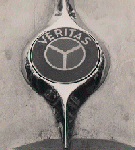

This small company, although lasted only for a couple of years did more
to the German motorsport than many others for decades.
After the War ex-BMW engineers Ernst Loof and Lorenz Dietrich set up their
own shop to convert BMW 328s into racecars in Baden.
Then they moved to the French zone where they offered various models, but
then they became too ambitious and the project folded.
Loof returned to Nürburgring and the then with the financial help
of Heinkel constructed several models until 1953, when he returned to BMW.
In all 78 models from the Veritas workshop saw the light. Below You'll
find pictures and info on some of them.
Most of the period black & white pictures were taken
by "Leica-Studio Wörner". The Wörner archive is now possessed
by the American Road and Track magazine. They kindly loaned me these pictures.
Reproduced with permission.
 Veritas 2-liter Renn-sportwagen
Photographer not mentioned. From the R&T archives.
Veritas 2-liter Renn-sportwagen
Photographer not mentioned. From the R&T archives.
 "Holbein at the wheel of
a BMW one-off". Photo: Wörner. [Take note of the different nose]
"Holbein at the wheel of
a BMW one-off". Photo: Wörner. [Take note of the different nose]
 Veritas 2-liter Sport
coupé. Photo: Wörner.
Veritas 2-liter Sport
coupé. Photo: Wörner.
The BMW 328 based cars. Powered by the 328's two-litre six.
The coupé's caption said:
"The new two-seater Veritas-coupé. Journalists with Director Dietrich from the Veritas Gmbh standing beside the new Veritas coupé. From left stands EHO, middle Dietrich and right Gü Molter.
The usual form of the Veritas sportscars has been kepts, the Coupé received a "hat".
 Photo T.C. March, Sudbroke, Lincoln,
England.
Photo T.C. March, Sudbroke, Lincoln,
England.
 Photo March
Photo March
Silverstone, 10 May, 1952. At the wheel: Toni Ulmen.
 Veritas Saturn Photo Wörner
Veritas Saturn Photo Wörner
The new Veritas "Saturn" sports coupé, the newest product of the Veritas works... This new three-seater coupé is delivered with new 100 bhp Veritas-engine and five-speed transmission.
 Veritas Scorpion Photo Wörner
Veritas Scorpion Photo Wörner
 Veritas Jupiter Photo Wörner
Veritas Jupiter Photo Wörner
And now for something different: the Dyna-Veritas:
In conjunction with the French Panhard Veritas introduced a small cabriolet
in 1950 on Dyna-Panhard base. I'm not sure, but I think pre-dates the
French Deutsche-Bonnet venture, also on Panhard.
A separate company, under the name Dyna was established. Lorenz Dietrich
was the manager. The bodies were made by the Stuttgarter Karl Baur.
Baur made several BMW conversion before and after the War. Nowadays, they
convert BMWs to special cabriolets.
The Veritas-designed bodies were bolted to a tubular frame. It was
powered by a 744cc flat-twin Panhard engine.
The car lasted for two years and 176 of them saw the light. Main problem was:
although the car looked nice, it was Panhard-based (French) so the Germans
didn't have the intention to buy it.
 Dyna-Veritas at the Baden-Baden Sanitarium
Photo: Wörner.
Dyna-Veritas at the Baden-Baden Sanitarium
Photo: Wörner.
 Dyna-Veritas coupé Photo Wörner
Dyna-Veritas coupé Photo Wörner
 Dyna-Veritas Photo Wörner.
Dyna-Veritas Photo Wörner.
"After the War brought Veritas the Dyna-Veritas to the market in small series with a 750 cc Pahnard-engine."
 Dyna-Veritas S Photo Wörner
Dyna-Veritas S Photo Wörner
"The new Dyna-Veritas-S sportscar with folding top"
Copyright September, 1996.
Paul Negyesi npal@enet.hu